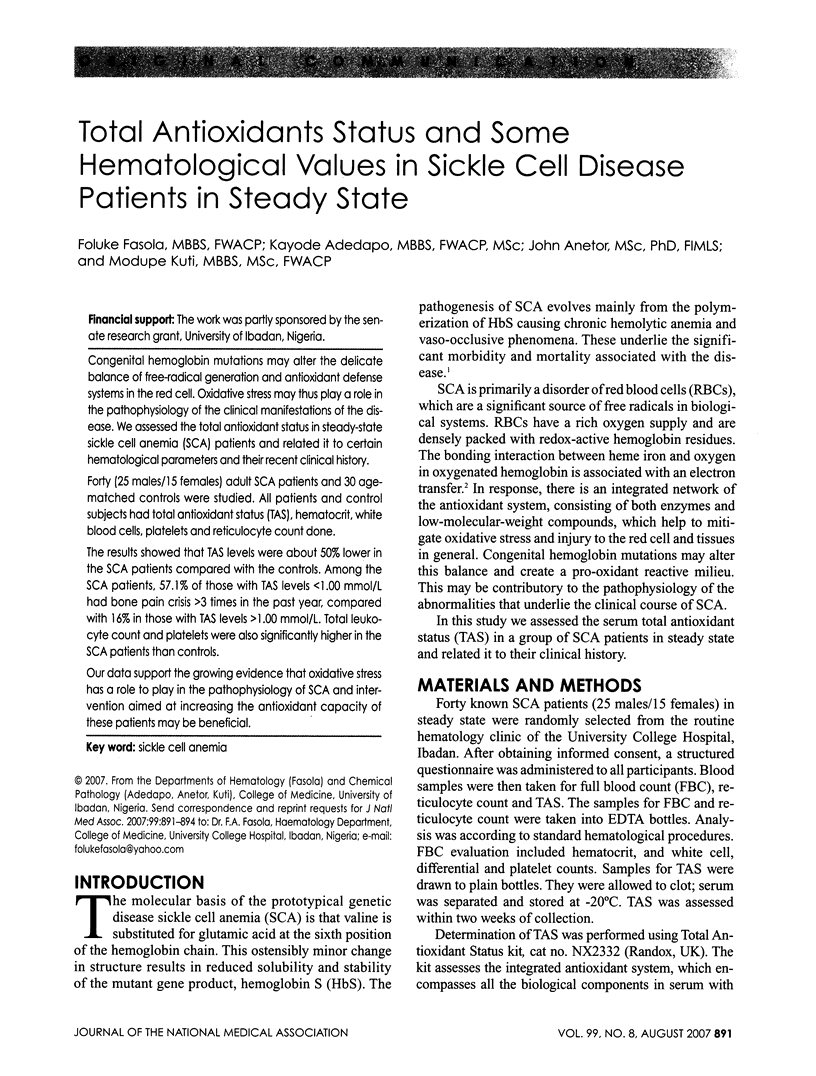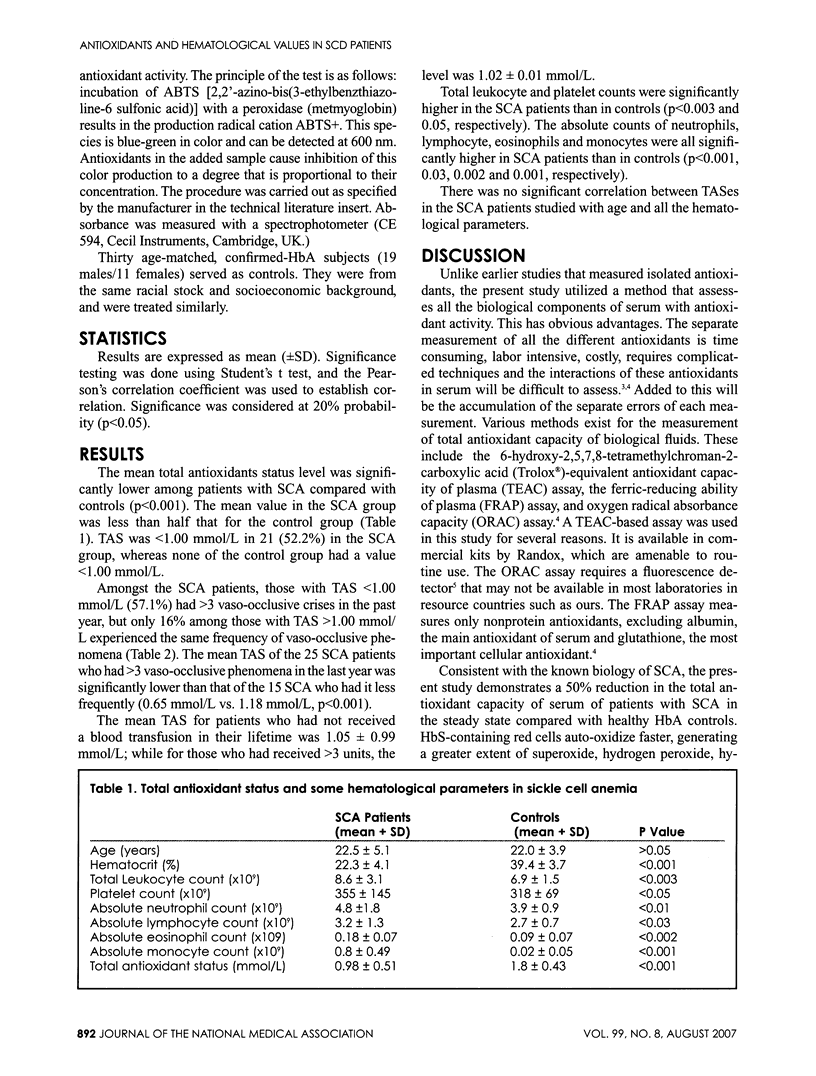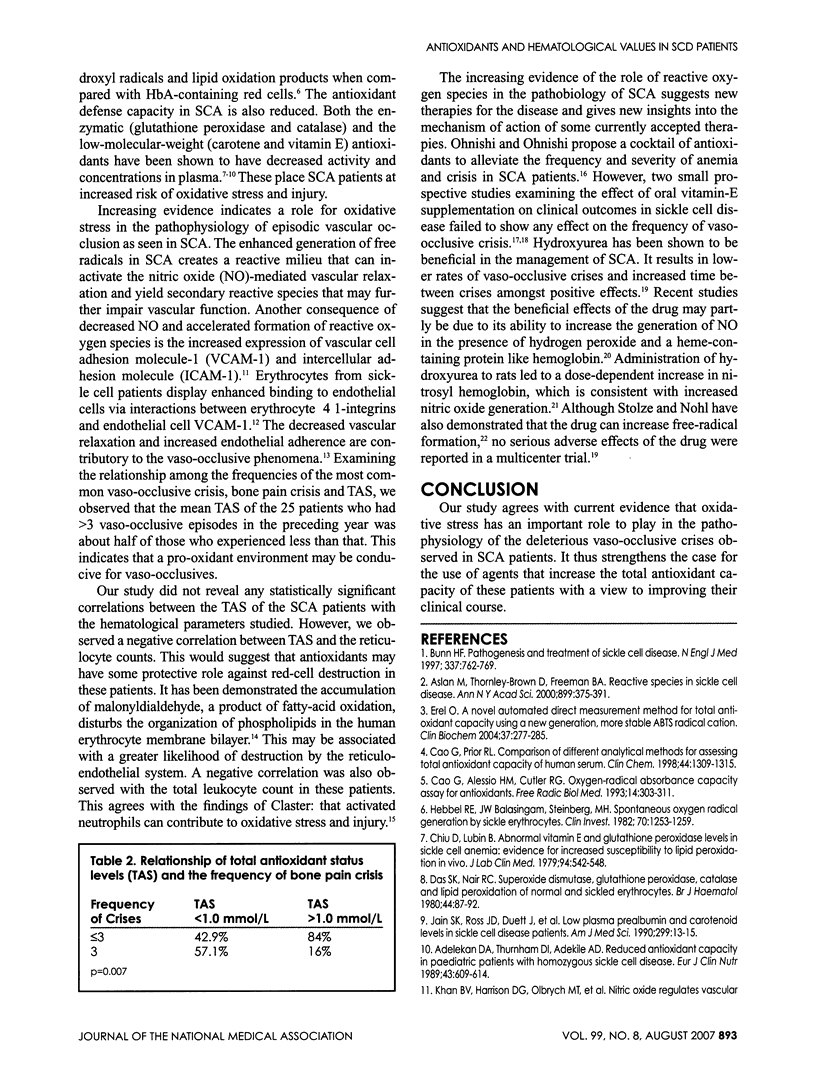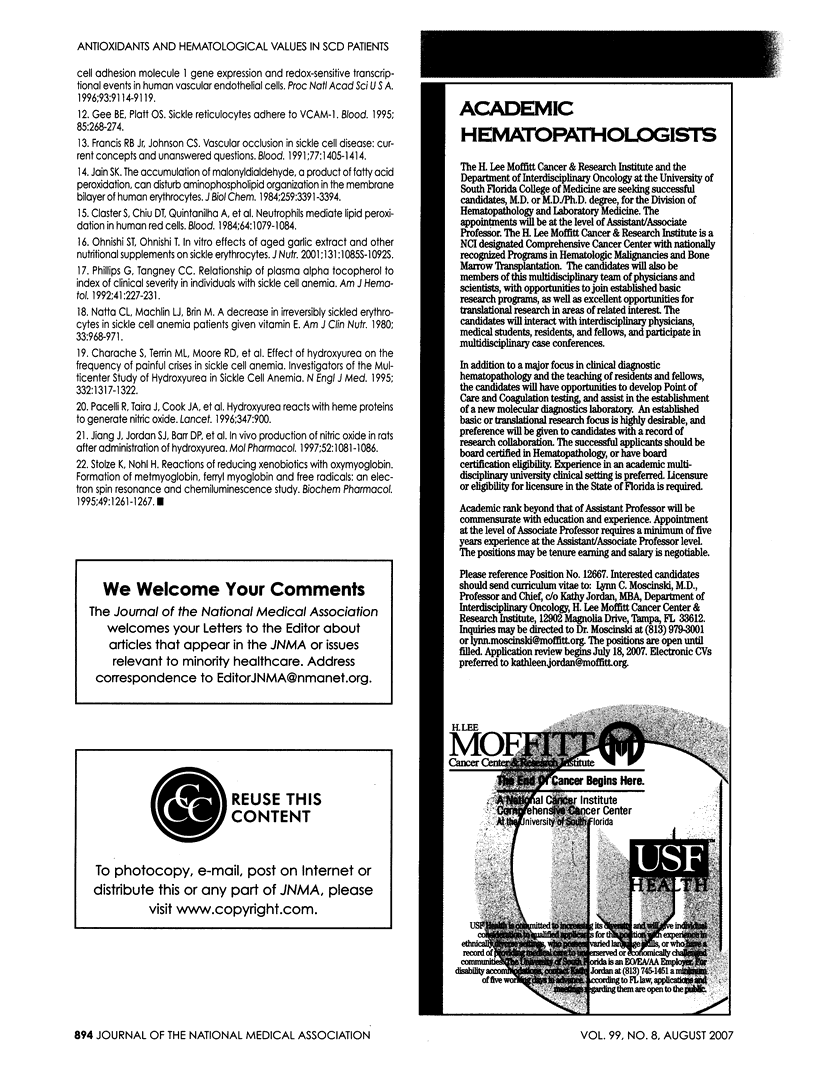Abstract
Congenital hemoglobin mutations may alter the delicate balance of free-radical generation and antioxidant defense systems in the red cell. Oxidative stress may thus play a role in the pathophysiology of the clinical manifestations of the disease. We assessed the total antioxidant status in steady-state sickle cell anemia (SCA) patients and related it to certain hematological parameters and their recent clinical history. Forty (25 males/15 females) adult SCA patients and 30 age-matched controls were studied. All patients and control subjects had total antioxidant status (TAS), hematocrit, white blood cells, platelets and reticulocyte count done. The results showed that TAS levels were about 50% lower in the SCA patients compared with the controls. Among the SCA patients, 57.1% of those with TAS levels <1.00 mmol/L had bone pain crisis >3 times in the past year, compared with 16% in those with TAS levels >1.00 mmol/L. Total leukocyte count and platelets were also significantly higher in the SCA patients than controls. Our data support the growing evidence that oxidative stress has a role to play in the pathophysiology of SCA and intervention aimed at increasing the antioxidant capacity of these patients may be beneficial.
Full text
PDF



Selected References
These references are in PubMed. This may not be the complete list of references from this article.
- Adelekan D. A., Thurnham D. I., Adekile A. D. Reduced antioxidant capacity in paediatric patients with homozygous sickle cell disease. Eur J Clin Nutr. 1989 Sep;43(9):609–614. [PubMed] [Google Scholar]
- Aslan M., Thornley-Brown D., Freeman B. A. Reactive species in sickle cell disease. Ann N Y Acad Sci. 2000;899:375–391. doi: 10.1111/j.1749-6632.2000.tb06201.x. [DOI] [PubMed] [Google Scholar]
- Bunn H. F. Pathogenesis and treatment of sickle cell disease. N Engl J Med. 1997 Sep 11;337(11):762–769. doi: 10.1056/NEJM199709113371107. [DOI] [PubMed] [Google Scholar]
- Cao G., Alessio H. M., Cutler R. G. Oxygen-radical absorbance capacity assay for antioxidants. Free Radic Biol Med. 1993 Mar;14(3):303–311. doi: 10.1016/0891-5849(93)90027-r. [DOI] [PubMed] [Google Scholar]
- Cao G., Prior R. L. Comparison of different analytical methods for assessing total antioxidant capacity of human serum. Clin Chem. 1998 Jun;44(6 Pt 1):1309–1315. [PubMed] [Google Scholar]
- Charache S., Terrin M. L., Moore R. D., Dover G. J., Barton F. B., Eckert S. V., McMahon R. P., Bonds D. R. Effect of hydroxyurea on the frequency of painful crises in sickle cell anemia. Investigators of the Multicenter Study of Hydroxyurea in Sickle Cell Anemia. N Engl J Med. 1995 May 18;332(20):1317–1322. doi: 10.1056/NEJM199505183322001. [DOI] [PubMed] [Google Scholar]
- Chiu D., Lubin B. Abnormal vitamin E and glutathione peroxidase levels in sickle cell anemia: evidence for increased susceptibility to lipid peroxidation in vivo. J Lab Clin Med. 1979 Oct;94(4):542–548. [PubMed] [Google Scholar]
- Claster S., Chiu D. T., Quintanilha A., Lubin B. Neutrophils mediate lipid peroxidation in human red cells. Blood. 1984 Nov;64(5):1079–1084. [PubMed] [Google Scholar]
- Erel Ozcan. A novel automated direct measurement method for total antioxidant capacity using a new generation, more stable ABTS radical cation. Clin Biochem. 2004 Apr;37(4):277–285. doi: 10.1016/j.clinbiochem.2003.11.015. [DOI] [PubMed] [Google Scholar]
- Francis R. B., Jr, Johnson C. S. Vascular occlusion in sickle cell disease: current concepts and unanswered questions. Blood. 1991 Apr 1;77(7):1405–1414. [PubMed] [Google Scholar]
- Gee B. E., Platt O. S. Sickle reticulocytes adhere to VCAM-1. Blood. 1995 Jan 1;85(1):268–274. [PubMed] [Google Scholar]
- Hebbel R. P., Eaton J. W., Balasingam M., Steinberg M. H. Spontaneous oxygen radical generation by sickle erythrocytes. J Clin Invest. 1982 Dec;70(6):1253–1259. doi: 10.1172/JCI110724. [DOI] [PMC free article] [PubMed] [Google Scholar]
- Jain S. K., Ross J. D., Duett J., Herbst J. J. Low plasma prealbumin and carotenoid levels in sickle cell disease patients. Am J Med Sci. 1990 Jan;299(1):13–15. doi: 10.1097/00000441-199001000-00004. [DOI] [PubMed] [Google Scholar]
- Jain S. K. The accumulation of malonyldialdehyde, a product of fatty acid peroxidation, can disturb aminophospholipid organization in the membrane bilayer of human erythrocytes. J Biol Chem. 1984 Mar 25;259(6):3391–3394. [PubMed] [Google Scholar]
- Natta C. L., Machlin L. J., Brin M. A decrease in irreversibly sickled erythrocytes in sicle cell anemia patients given vitamin E. Am J Clin Nutr. 1980 May;33(5):968–971. doi: 10.1093/ajcn/33.5.968. [DOI] [PubMed] [Google Scholar]
- Ohnishi S. T., Ohnishi T. In vitro effects of aged garlic extract and other nutritional supplements on sickle erythrocytes. J Nutr. 2001 Mar;131(3S):1085S–1092S. doi: 10.1093/jn/131.3.1085s. [DOI] [PubMed] [Google Scholar]
- Pacelli R., Taira J., Cook J. A., Wink D. A., Krishna M. C. Hydroxyurea reacts with heme proteins to generate nitric oxide. Lancet. 1996 Mar 30;347(9005):900–900. doi: 10.1016/s0140-6736(96)91378-1. [DOI] [PubMed] [Google Scholar]
- Phillips G., Tangney C. C. Relationship of plasma alpha tocopherol to index of clinical severity in individuals with sickle cell anemia. Am J Hematol. 1992 Dec;41(4):227–231. doi: 10.1002/ajh.2830410402. [DOI] [PubMed] [Google Scholar]
- Stolze K., Nohl H. Reactions of reducing xenobiotics with oxymyoglobin. Formation of metmyoglobin, ferryl myoglobin and free radicals: an electron spin resonance and chemiluminescence study. Biochem Pharmacol. 1995 May 11;49(9):1261–1267. doi: 10.1016/0006-2952(95)00046-3. [DOI] [PubMed] [Google Scholar]


